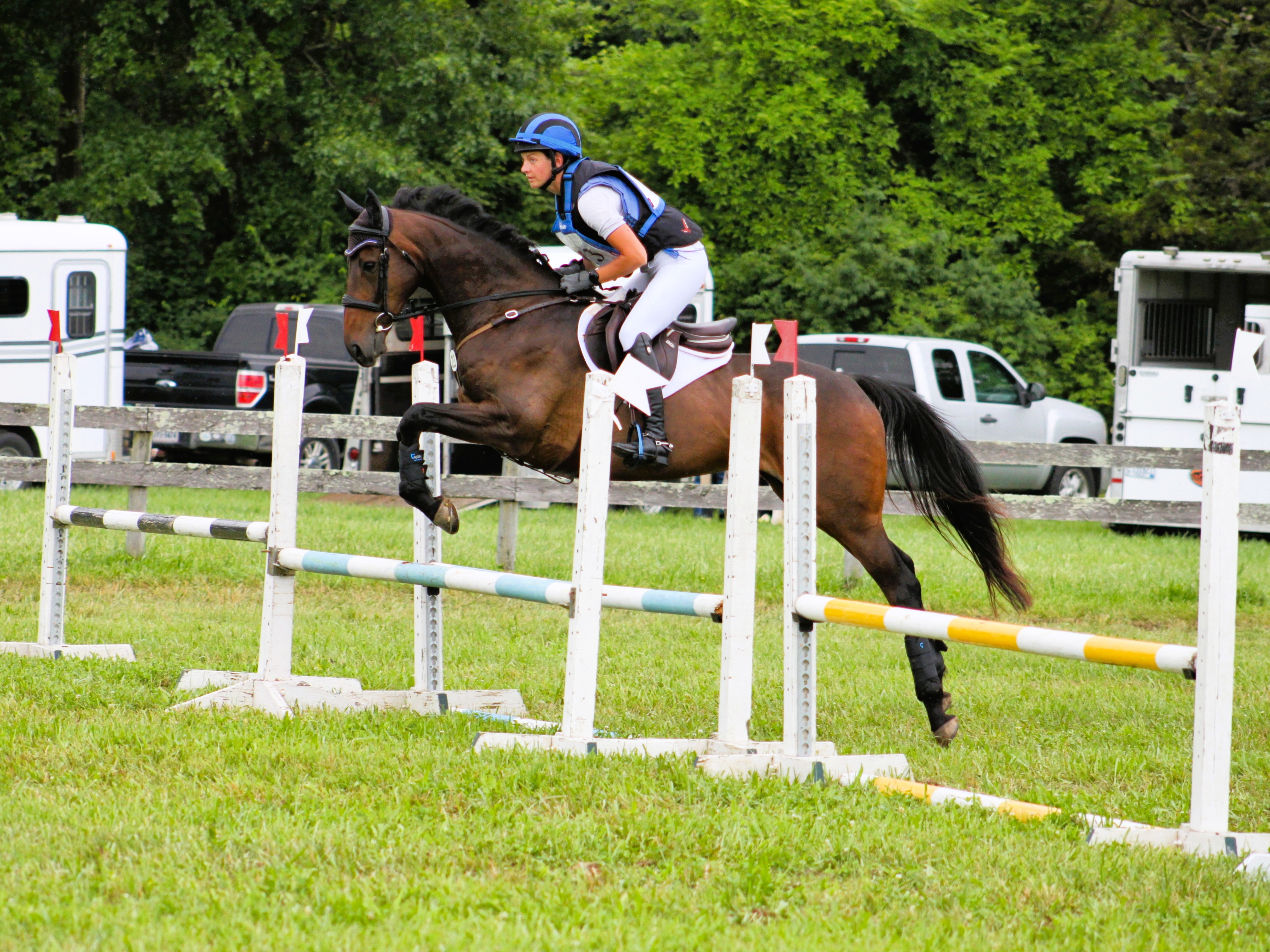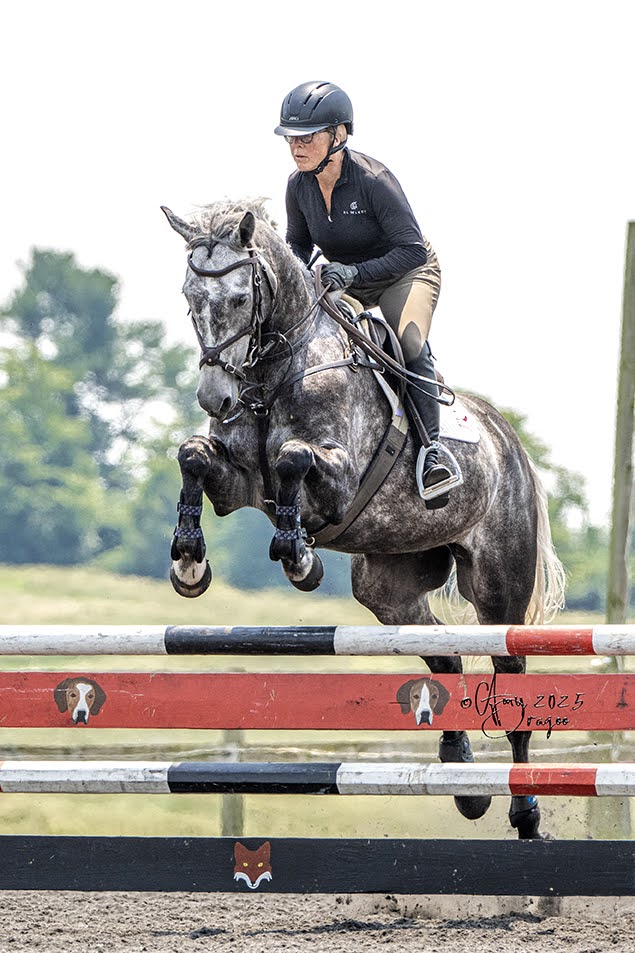I have vivid memories of sitting in the backseat of my parent’s car, imagining I was galloping my favorite lesson pony down the median. I would think about how much fun it would be to jump that brush, soar over that ditch, and keep pace with the cars. What horse-crazy kid hasn’t had these exact thoughts? Well, if you grew up near Diego Farje in Peru, you may not have had to use your imagination…
Diego is best known in the United States as the current head rider for Boyd Martin. But Diego’s story really begins in his hometown in Peru, where he originally got his start with horses as a show jumper. Unlike in the States, horseback riding is not a casual hobby in Peru. Those who have access to horses are either extremely rich or have ties to the military or law enforcement. Diego was lucky enough to have ties to horses through the mounted police.

Horseback riding was a family affair for Diego Farje. Photo courtesy of Diego.
“It was kind of a family tradition since my great grandfather got into the mounted police. While they use the horses for protests and for security, they also have a show jumping team. The same horses they would use for police work, they would use for show jumping. I got my start riding because my father was working for the mounted police at that time. My brother and my mom used to compete as well. So, we would all go together,” said Diego.
It was actually Diego’s father who first suggested he make the switch to eventing. “[Peru] was hosting the qualifications for the Pan Ams, and my dad had this idea. He said, ‘I heard about this thing called eventing…’”
The idea was that since you didn’t have to jump as high in eventing as compared to show jumpers, the horses wouldn’t be as expensive, Diego would have the opportunity to learn about other disciplines, and he would be more likely to get onto an eventing team.
The only problem? The only eventers to be found are part of the Peruvian army. According to Diego, “The army is really the only place where we have eventing, and even then, it’s not actually a huge thing. There were only four riders and I was the only civilian eventer. Everyone else was from the army.”
Another big obstacle was Diego’s access to terrain to practice on. He had to get creative: “The place I was riding at didn’t have any cross country jumps and it was pretty close to the beach. I used to do my conditioning work by going to the beach, and then just galloping on the coast, on the shore, to get conditioning. I would figure it out as I went.”
But here is where Diego casually drops a bomb into our conversation.
His options for cross country schooling weren’t just limited — they were non-existent. His solution? Use the median of the Peruvian highway as his own personal cross country course (don’t try this at home, kids).

A between-the-ears view of Diego Farje training on the median of a highway in Peru.
“On the way home from the beach, we had this highway with the big grass down the middle and big brushes. The brushes were almost Advanced height with telephone poles and cables in between. So I would have lines of like four or five strides with brushes in between and I would jump like ten in a row. I mean, for sure they were not designed to be jumped, but…” he pauses and then adds, almost sheepishly, “It was the only thing that I had that looked like a cross country jump!”
Diego is the poster child for being a student of the sport. Even when he had zero access to resources and was living in a country that had hardly ever heard of eventing, he persevered. “I was trying to figure out how to do things by myself in a decent way, when I didn’t even have an idea of how to do it properly. I was watching videos, you know YouTube videos, on how to do it, how to ride dressage, or even show jumping. I was really trying to do anything that could help me.”
Two years before the Pan American Games, he enlisted the help of Brazilian trainer Rafael Annunciaçao to take a horse who had never done anything but show jumping and transform him into an eventer. Their hard work paid off. “At the Pan Ams, I got the best place ever achieved by a Peruvian rider. I finished cross country clear, finished show jumping clear, and I finished in eleventh place. And my only goal was just to finish it.”

Diego Farje and Qouter at the Pan American Games. Photo by Amando Cavero
Diego credits his success to Rafael’s tutelage and to his close connection to his ride at the time, Qouter. “We connected really, really, really, really well, this horse and I. This horse just gave me everything.”
The high of winning didn’t last long. Sadly, at a later event Diego and Qouter got a bad distance into a jump and had a rotational fall, causing Diego to break his collarbone. Diego’s Olympic eventing dreams and immediate hopes of a professional eventing career vanished. “All my dreams were just like, poof.”
Fate had other plans. A year later he got a call from an old connection offering him a position in Florida. Two days later, he had booked his ticket and was on his way to the United States. Today, Diego is happily riding and training with Boyd Martin.

Photo courtesy of Equestly
His favorite part of working with Boyd? “All the learning opportunities. It’s one of the biggest programs in America, I would say, and it’s one of the busiest, too. I’m so lucky to learn from Boyd and his coaches and every time they come I get to learn from them.”
It’s clear that Boyd and Diego have a close relationship. “He knows I want to make a living out of riding and be a professional at the highest levels of the sport one day. We met at the Pan Ams, so, I think it would be a dream to one day compete together at the Olympics. I feel like he’s a father to me, you know, especially with not having my family here.”
Diego has even gotten hooked on Boyd’s famous (infamous?) ice baths. The two had a competition going on to see who could stay in the water the longest. But Diego says that once they got up to 15 minutes at a time, he called it quits. Now, he limits his ice baths to five minutes and says there’s massive benefits. “One of the nice things I’ve learned from ice baths is how to train yourself for competitions, for pressure, for stressful situations.”

Diego Farje and Boyd Martin’s Schmick show off the after-burners en route to winning the 2022 USEA Young Event Horse 4-Year-Old East Coast Championship. Photo by Shannon Brinkman Photography.
His biggest dream for the future is to have a horse of his own. “One day I would love to have my own horse. I hadn’t had my own horse, ever. And it’s hard not to get attached [to client horses]. But I think that’s part of your career as a professional. You cannot be attached, unless you have a horse of your own.”
While his days of dodging telephone poles and galloping down the median of his local highway may be in the past, I think we’ll see a lot from this rider in the years ahead, particularly with the added support of his sponsor, Equestly — stay tuned for more on this in our next blog following Diego’s journey as a rising pro in the sport!
This article and series following Diego Farje is brought to you with support from Equestly.
View this post on Instagram




















